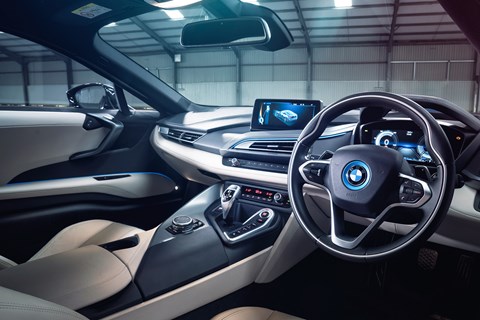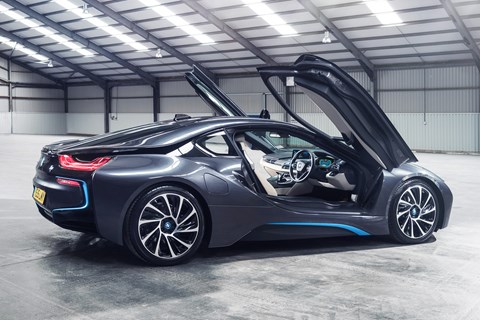► The best used car deals out there
► Save £35k on a BMW i8
► Common sense meets science fiction
Four good reasons to fall for BMW’s electric revolutionary…
1) It’s a hybrid that doesn’t drive like one
Given the car’s modest tyres (195/50 20 and 215/45 20) and equally unassuming on-paper performance (a combined 357bhp) you might be forgiven for thinking the i8’s not really a sports car, more a Prius-esque lifestyle statement riding beneath a fuselage from Interstellar. After all, looking like a renegade concept car is enough, isn’t it? But get the i8 moving and it’s an inspired thing, flowing down the road with balance, agility and a really likeable lightness of touch.
There’s speed too – don’t forget the speed. To an extent the car’s carbon composite construction cancels out the battery’s weight penalty, so the car weighs in at a really not that bad 1560kg. And thanks in part to all-wheel drive – the engine drives the rear axle, the electric motor the front – 0-62 comes up in 4.4sec (quicker than a manual M2). What’s more, the harder you push the i8 the more effectively it recharges its cells. Press on, save the planet. 4
2) It’s BMW’s Porsche 911
The 911 had it too good for too long, becoming the default option for anyone entertaining the idea of a handsome, quick, rewarding and practical coupe that could occasionally seat four. Suddenly, and with a very unlikely set of ingredients, BMW had an alternative. Priced at just over £100,000 new and with an innovative powertrain built around an unlikely hero – a turbocharged 1.5-litre turbo triple – the i8 didn’t look like much of a 911 rival.
Then you spend time with it, marvelling at its versatility, refinement and four-seat practicality. You’ll never get bored of running a hand over the bare carbonfibre of the door aperture, just as you’ll never get bored of the all-pervading sense of lightness (thanks in part to the fine electric power steering and the e-motor’s immense torque, cancelling out the car’s weight). And it’ll be a long time before you become blasé about being able to move off silently, drive to work without using any petrol or gain range from braking. (Remarkably, that brake pedal doesn’t feel hideous either, despite the regenerative systems working hard to muddy the waters).
3) It makes sense secondhand
‘The plan with i8 was always to make the ownership experience as normal as possible,’ explains Wollaston BMW sales manager Andy Payne. ‘The car itself is different enough, so everything else was designed to feel familiar. You don’t lease the battery – you wouldn’t lease an engine, so with an i8 the battery’s integral to the car and is under warranty for eight years. There’s not much to worry about on the servicing side either. Look for a car with the with Service Inclusive cover. It was £1280 originally and covered regular service items (engine oil, micro filter and brake fluid, discs and pads) for 5 years or 60,000 miles – nice to have.
BMW offers two fast wall chargers but they’re not essential – just driving the car in Sport mode will charge the battery pretty quickly, and a full charge on a three-pin plug at home only takes 4-5 hours. Who buys them? In my experience it’s people who want performance but like the way the i8 delivers it; without a big and noisy conventional petrol engine.’
4) It’s beautiful
It’s subjective, sure, but the i8’s blend of key BMW design references, dramatic mid-engine proportions and futuristic surfacing remains as stunning today as it was when the i8 Concept was unveiled at the 2011 Frankfurt show. Form over function? Hardly. The boot might be small, rear visibility lacking a little and the entry procedure tricky until you’ve mastered it, but the i8’s no diva to live with, being easy to drive and superbly comfortable. Inside it’s standard-issue BMW given a twist; intuitive control with a little sci-fi visual lightweighting.

BMW i8
From £70k (£104,540 new)
1.5-litre 3-cyl turbocharged + e-motor, 357bhp, 4.4sec 0-62mph, 155mph (limited)
One we found
Metallic white with black leather, 11,000 miles, BMW approved used, service plan, Harmon Kardon sounds, driving assistant with surround view, £75k
Buying intel
> Prices range from £70k (25,000 miles) to £95k (5000 miles)
> Grey was the no-cost paint; stunning Crystal White sought-after
> Standard kit included DAB radio, head-up display and heated seats
> Optional blue seatbelts (£310) and carbonfibre trim (£1700) hardly essential
> Look for a car with the pre-paid service plan

Or an £18k i3?
Available in two guises – pure electric and range extender – the i3 is BMW’s future shock city car; progressive styling, lounge-cool interior, peppy single-pedal progress. Range extender cars make up 85% of i3 sales, reflecting the nascent state of the UK’s on-the-move charging infrastructure. Pure EV i3s start at sub-£18k, but you’ll need £20k or more for a range extender example. Be prepared to pay a lot more for something with a semblance of opulence – entry-level cars are meaner than a Guantanamo breakfast.
Used car stars 2016 continued…
Used car stars 2016: Peugeot RCZ-R vs Audi S5
Used car stars 2016: Jaguar F-type vs Porsche Boxster S
Used car stars 2016: Mercedes S-class vs Lexus GS
Used car stars 2016: VW Tiguan
Used car stars 2016: 208 GTi vs Swift Sport vs Focus ST
Used car stars 2016: Ferrari 458 Italia
Read more from the June 2016 issue of CAR magazine